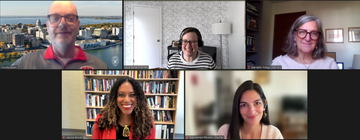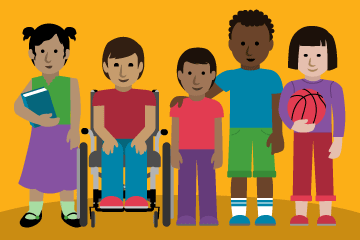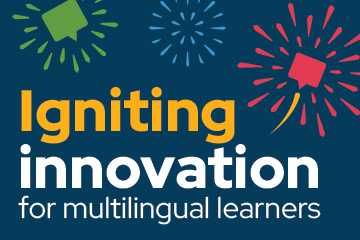Conversations with Tim: Building classroom communities

This edition of Conversations with Tim features a discussion between Tim Boals, WIDA founder and director, Jessica Lee Stovall and Rita Kamani-Renedo. Jessica and Rita are working on doctorate degrees at Stanford Graduate School of Education at Stanford University. Jessica’s work focuses on the intersection of Black studies and education. Rita is working in the areas of race, inequality and language in education, as well as curriculum and teacher education.
Tim, Jessica and Rita joined Merideth Trahan, WIDA chief of staff, to talk about building classroom communities – everything from the how to the why. Plus, Jessica and Rita share their thoughts on how to stay engaged and excited about teaching.
Listening option: Listen to the audio here or continue reading this abridged version of their conversation.
Tim: I am so thrilled to have two up-and-coming scholars, Jessica Lee Stovall and Rita Kamani-Renedo, here today who have already contributed so much to the field of education. Why don’t you introduce yourselves?
Jessica: I'm a fifth-year Ph.D. candidate at the Stanford Graduate School of Education. My work is at the intersection of Black studies and education. I look at the ways that Black teachers work together to create spaces for their thriving.
Rita: I am a second-year student in the doctoral program for race, inequality and language in education, as well as curriculum and teacher education at the Stanford Graduate School of Education. My work focuses on critical pedagogies with multilingual and transnational youth.
Tim: It’s so good to have you two with us! I'm going to ask the first question of Jessica. Throughout our conversation today, I'd like us to talk about building community, plus what teachers can do to find joy and excitement in teaching. Jessica, can you kick us off by talking about what we mean when we say building community in the classroom, and then share a few big-picture things that teachers can do to create community?
Jessica: When I think of building community, I think of building spaces where students can show up authentically, they aren’t afraid to make mistakes. They're able to try out different parts of their identities without fearing ridicule or bullying, and there's vibrancy, joy, laughter and teasing. Some of the things that you would see in a home.
When I think about how to create this community, I think a lot of it is bringing back the human. Teachers, we have so much on our plates. There are new court mandates, new expectations, and standards to meet. We're in the third year of a global pandemic. One of the first things that goes when we're under all this stress is the human. What I've done in my own classroom is make sure that every single student feels seen. That might be the way that I greet students when they walk into the classroom, like starting with an icebreaker where every single student gets to share, even if it's just a number, 1-10, about how they're doing that day. I love to do surprise birthday parties, where I surprise students as they walk into the room. I have cake and candles. When things are challenging – there's a tragic event that happens in the community, either locally or in the world – we push all the desks to the side and sit on the floor and do a restorative circle.
Unfortunately, there are some students that go an entire day without feeling like somebody even looks them in the eyes. Having these powerful moments of connection through storytelling and joy is one way to think about building that community.
Tim: That is so important given the three years we've just experienced. I know teachers are under so much stress right now. Rita, Let's talk about teachers who work with multilingual learners. Are there specific things that we can do to build community and connect with students as well as colleagues throughout the school building?
Rita: There are lots of ways to build a community that allows students to share parts of themselves that often go unnoticed in the context of school, where we invite students to bring their whole selves. I think it's important for teachers to model this. Not just to ask students to do that, but for us to do that to build those connections. I worked for several years as a teacher at a newcomer school. All my students were classified as English language learners. I wanted to be able to share elements of my own story and experiences with migration, identity and multilingualism. That became a way for me to model to students that those parts of who I am are important to me as a human being and teacher. And that they belong in the school space. I think a lot of times students wonder if they can bring those parts of who they are into the classroom.
Sometimes a question as simple as the last song that you listened to, or your favorite kitchen aroma can reveal a lot about students' lives. I also loved opportunities where students could share themselves creatively and multimodally. Things like creating vision boards, integrating art, creativity, music and poetry into our curriculum, decorating our classroom notebooks and decorating the classroom. Those were ways to build community and show that students had a voice in shaping what their classroom looks and feels like. It could be something collaborative in the whole school building, to create an opportunity for all teachers, adults and students in the building to shape what that community looks and feels like.
Tim: I see some common threads with what both of you are saying about building this inviting space where students can be themselves and nurture and grow their identities. Jessica, an important piece of building community is equity. I want our readers to know that in 2018 you and your students were featured in “America to Me,” a documentary series that examines racial, economic and class issues in contemporary American education. The series is incredible, and I encourage everyone to watch it. Jessica, can you tell us about that experience and some of the insights that you took from that series?
Jessica: A few months after the docuseries aired, I was walking around Times Square and there was a white police officer who was staring at me. I started wondering if I did something wrong. He approached me and said, “Are you in that documentary?” I was so shocked, and I said, “Yes.” He told me how much the docuseries impacted the way he viewed his career as a police officer and that it helped him think about issues of race in a different way, and it fundamentally changed the way that he walked as an officer in New York City. I thought how powerful that was – that a series about education is really about the microcosm of issues of race that happen all over.
One thing that has been motivating me, and my research on Black teachers, is after the series aired, I had so many Black teachers from all over the U.S. tell me that they saw themselves in my story, in my push to try to disrupt some of the anti-blackness that was happening in the school, and the exhaustion of being told “no” or “you can't do that” over and over again. It was really powerful to understand how many teachers have a desire to reimagine schools but feel stuck in their capacity to do that. It has motivated my research and thinking about what sorts of spaces it takes for Black teachers, and all teachers, to be able to thrive in education. What will it take for us to reimagine what education can and should be?
Tim: One of the things that comes up in the series is how much you care for every single student in your class, and how much you put into it. I think a lot of teachers can relate to that, and it's tough. There's so much to do and there are only so many hours in the day. I know it’s exhausting work to care that much. But it's powerful to see.
Merideth: One of the core themes in the new WIDA ELD Standards Framework, 2020 Edition is equity. Tim, can you tell us a little bit about how the 2020 Edition fits into this concept of building community in the classroom and beyond?
Tim: The 2020 Edition is innovative in several ways. At WIDA, we’ve always believed in a more functional approach to language development because we believe that language is learned as students participate in content classes that are challenging for them. It's not something you wait and do after they have “enough English.”
With the 2020 Edition, we took that one step further by emphasizing the idea of engagement. The 2020 Edition provides the benchmarks and ideas that teachers can use to focus on things like, “What should my school’s curriculum look like to maximize learning in all parts of the school?” It’s not just a question of learning English, it's a question of students being able to learn everything within the school building and give teachers the ideas to build that community, to build those engaging spaces that we want to see. If you haven’t seen the 2020 Edition, when you do, I think engagement will jump out at you – the opportunities to get kids talking about science, math, social studies, or whatever the subject area is to get them talking and participating in those community spaces you were talking about.
Rita, since families are such an important part of a community, what are some ways teachers can make sure families are part of the school community?
Rita: Language accessibility is of particular importance. Certainly not the only thing that's important. But school districts need to make sure that materials, resources and events, like family conferences, are accessible to multilingual families. Funds should be dedicated to hiring interpreters.
Other things that teachers and schools can do are… in our school, student leaders had the opportunity to volunteer at school events. They served as guides, hosts and interpreters for families coming into the school. They helped with things like guiding families to the correct classrooms. It reinforced the message that multilingualism is a gift and an asset. Families can tell when they are being treated like burdens versus being treated like an integral part of the school community. Our school also had an advisory system, sometimes it's called Home Room, where there's one teacher or adult in the school who serves as the liaison between families and the school, which allows for relationships to be built. Having the ability to create relationships that are long-lasting – where a parent or an uncle or grandmother knows you and will reach out to you – can start to feel like a family within a school, and that's important.
Tim: So many important things you said, Rita, about honoring families, giving them agency and making sure we honor their languages and cultures, and that we see them as equal partners in the education of their students. I’d like you both to answer this next question: How have community-building practices changed in the past few years? In what ways have virtual tools expanded community building between students, teachers and families?
Rita: Up until the end of the 2020-2021 school year, I was teaching. I experienced that major shift into quarantine and pandemic school. We learned a lot about the pros and cons of technology in that experience. Technology opened a lot of doors. For example, a parent who had a concern about childcare might have had a difficult time coming to school during parent-teacher conferences. But using tools like WhatsApp and Facetime made it a lot easier for families to stay in touch. I really appreciate what technology has afforded us in terms of access. There are some disadvantages and boundary crossing. For me, going online meant that I was in constant contact with a lot of my students. I was constantly on the phone – and using my personal phone. That takes its toll. A challenge for teachers in this increasingly digital age is making sure that we are still caring for ourselves and establishing boundaries so that we can continue to do this important work.
Jessica: In one of my recent studies, I interviewed 30 Black teachers about their experiences in schools. One of them talked about how the pandemic highlighted that when you get rid of the physical school building, you start to understand how much school is just a relationship. Fundamentally, it’s the connections between those that are educating and supporting our young people and the young people and their families. Technology allows us to keep those connections.
For the first two years of the pandemic, I worked with teacher candidates and a lot of them were surprised that some of the students did well with online learning because they didn't have the same pressures that they felt in a physical school building. This helps us to question what we're doing when we're teaching in both formats and what we can learn from these new ways of connecting with young people – especially when they're learning from their home, and they're learning from a place that for some is a safe space and is a space where they have connection. The pandemic let us reimagine what kind of spaces we can create, like what bell hooks called “home places in the classroom.”
Tim: Learning and working out of our homes has made it an interesting world in which we live today. Jessica, for my last question, I’ll start with you. What would you say to a teacher today who is struggling to stay engaged and excited about teaching?
Jessica: There's a reason why on the airplane they tell you to put on your oxygen mask before helping anyone else. Teaching is one of the most physically, emotionally taxing and exhausting professions. One of the most important, but also one of the most challenging. The first thing I would say is that if it's a real struggle, it's okay to step away. You have to put on your oxygen mask first. I taught for 11 years before I moved on. One thing that supported me was investing in myself and my own learning. For example, I decided to get my master's degree in literature. I carried the energy and excitement from my time reading books with other nerds into my own teaching as I was learning with my students. In my seventh year, I did a Fulbright program and spent a semester in New Zealand working with indigenous Maori people. I came back so energized. I find that the more I invest in myself, the more I invest in my own thinking, and my capacity to learn and experience. It inspires me to continue to do the work. Sometimes it's just a matter of changing things up and trying a new thing. It might be the catalyst that gets you through the next part of the year.
Rita: I appreciate what you just shared, Jessica. It took me back to moments in my teaching career. I taught for 10 years prior to starting graduate school and switching it up and investing in my own learning.
To all teachers, I would start by saying that I have tremendous respect for the work that you're doing. Like Jessica said, teaching is incredibly important and rewarding work but also challenging. I don’t think teachers get enough credit for the deeply intellectual work that is teaching and how creative and challenging it is. And I’ll go back to the point I shared earlier about teaching being about relationships and teaching us about relationships. That's often what got me through on those difficult days. Sometimes, I would focus on one key relationship – maybe with a student, a family member, or a colleague – that reminded me of why I do the work. Sometimes that's what you need to get through a challenging day or week. It can ground you in the work that you're doing, and that we need to continue to do.
Tim: I appreciate both of you and this sage advice. This has been a lovely conversation. I look forward to following both of your careers as you continue your scholarship, your research and your learning. I look forward to reading your articles and books that will come! Thank you so much, Jessica and Rita.
About Conversations with Tim
Conversations with Tim, WIDA Founder and Director is a WIDA news article series that features a conversation between WIDA Founder and Director Tim Boals and a colleague or two in the field of multilingual learner education. Together, they discuss the important innovation, research and collaboration taking place today.





